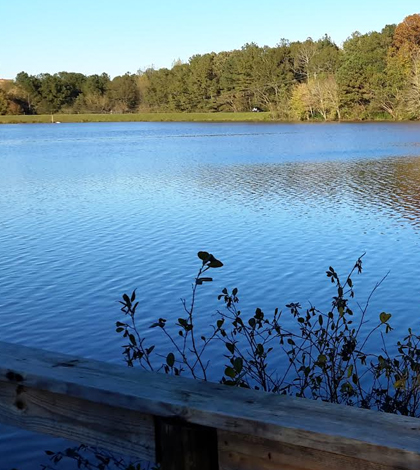Georgia’s Lake Herrick A Troubled Urban Lake

Lake Herrick. (Credit: Thalika Saintil / University of Georgia)
Teaching and learning about environmental science can be a lot of fun. But sometimes students lose enthusiasm just working on hypothetical scenarios. Well there’s no such danger of this apathy taking hold at the University of Georgia. That’s because educators and the students they’re teaching have a rallying cry: Lake Herrick.
The lake has for decades been the site of poor water quality punctuated by an issue with fecal coliform bacteria that researchers just haven’t been able to solve yet. And that’s for good reason, as studying the lake thoroughly simply can’t be done from a computer.
“You can’t do a lot of armchair hydrology, like looking at maps or Google satellite images,” said Todd Rasmussen, professor of hydrology and water resources at the university. “You’ve got to go out and beat the bushes back.” He notes that one recent find of a major inflow to Lake Herrick couldn’t have been found remotely. The stream was found instead by a researcher who had a hunch and decided to check.
Rasmussen and others involved with the work are coming at the lake’s problems from every angle that they can. This includes tapping the hydrology of the surrounding area, taking water quality measurements from the lake itself and assessing E. Coli levels with help from a local water treatment plant.
Lake inflows and outflows are measured using flumes and weirs installed at key points along streams connected to the lake. Water levels are tracked using HOBO water level loggers and ODYSSEY water level sensors. Precipitation, notably rain, is measured with the help of standard rain gages. Data on Lake Herrick’s water, including parameters like pH, conductivity, temperature and dissolved oxygen, are gathered using OTT Hydrolab water quality sondes.

Tipping bucket rain gauge and solar panel. (Credit: Thalika Saintil / University of Georgia)
There is also a real-time data collection effort relying on equipment designed by a faculty member to transmit findings. At the center of this gear are raspberry pi controllers that go along with GPS and cellular systems. Rasmussen says a major component of that part of the project is to teach others, like local citizen scientists, how to build similar devices.
And the hopes are that the things being done for Lake Herrick can in some way help all the other lakes throughout the state that are facing similar issues.
“In Georgia, we have a lot of urban lakes, which make for better house prices, as well as throughout the Southeast,” said Rasmussen. “One of the problems with urban catchments — the school of ecology calls it urban stream syndrome — all this stuff flows into the lake. People want to be able to use them for their amenities and so we want to devise new tools and techniques for monitoring these lakes.”
All of the approaches and gear that are being used so far will help with that, but so will another part of the project that is aiming to make all the data collected easily accessible. So far, that means posting Lake Herrick’s data online in graphical formats, which Rasmussen says is really only useful for the scientific community at this point. In the future, he and others would like to shake the presentation up a bit to make things easier to digest for the general public.
“With the real-time data, what we want to do is pull data into visualizations and have complete scientific info. Right now, they’re good for a geek but the public won’t know what it is,” said Rasmussen. “And so we have a lot of bright kids that want to solve problems — why not build something like that into a class project instead of some artificial one?”
Students are also putting forth solutions for helping to bring Lake Herrick back to being an asset for the surrounding community. These include ideas like encouraging beavers to come back to the lake and build dams that could increase water filtration, or building floating islands akin to the ones in Lake Titicaca that move around the water and take up nutrients. There are talks of improving wetland habitat nearby as well.
“We say, ‘OK, here’s a class project. What should we do?’ The students are evaluating literature to see what we can do,” said Rasmussen. “Lake Herrick’s a rallying point for our classes.”
Top image: Lake Herrick. (Credit: Thalika Saintil / University of Georgia)





0 comments